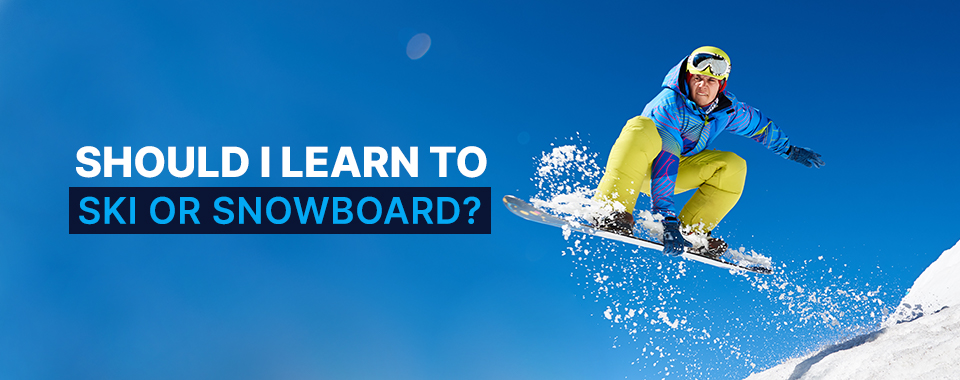 should i learn to ski or snowboard
should i learn to ski or snowboard
Should I Learn to Ski or Snowboard?
Posted
by
Matt Gahman
on Monday, January 25, 2021
A recent study shows skiers and snowboarders make up more than
3% of the United States population
— the highest number of active participants since 2014. Winter sports are a
thrilling, exciting way to stay active, challenge yourself and meet new
people, all while enjoying the great outdoors.
Two of the most popular snowsports for participants of all ages are
snowboarding and skiing. Though you can usually engage in either one at a
resort, they are very different sports that require unique skills,
abilities and equipment. If you're new to the world of winter sports and
aren't sure where to begin, this guide will help you learn more about
whether it's easier to snowboard or ski and how to make the best choice for
your abilities and budget.
Skiing vs. Snowboarding: The Basics
Before you learn more about skiing vs. snowboarding pros and cons, let's
take a closer look at the basics.
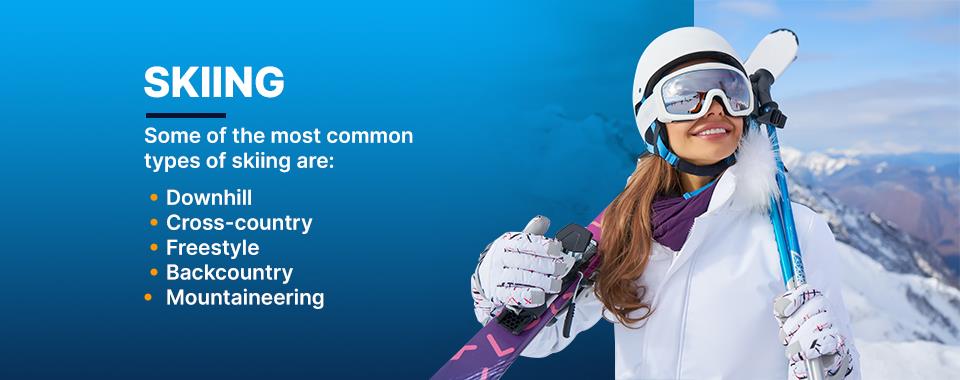
Skiing
Skiing involves two skis, boots, bindings and a pair of ski poles.
Together, you use them to glide uphill or downhill. Advanced skiers can try
more challenging poses, trails and speeds, depending on the type of skiing.
Some of the most common types of skiing are:
-
Downhill: Downhill skiing is one of the most popular and
beginner-friendly skiing methods, as it's what you typically find at a
ski resort. To downhill ski, you begin on a trail that matches your
experience level and ski down a hill, sometimes with small obstacles or
winding curves along the way. Once you reach the bottom, a ski lift
takes you back to the top of the trail for another round.
-
Cross-country: Aside from downhill, cross-country is the second type of
skiing you may have heard of before. It's an exercise in endurance and
stamina, as it involves propelling yourself with your ski poles across
a flat terrain instead of down a hill. Some ski resorts have
cross-country trails for a controlled practice environment.
-
Freestyle: Freestyle skiing is all about perfecting tricks and stances.
Freestyle skiers spin, turn and flip on the half-pipe or natural
outdoor hills. This type of skiing is not beginner-friendly but makes
for a fun goal once you've learned the basics.
-
Backcountry: Backcountry skiing is also known as ski touring, and it's
a type of skiing that focuses on exploration instead of competition or
speed. Backcountry skiing may be a challenge for beginners, as it often
involves steep or rugged mountain terrain and confidence with one's ski
poles. It's a great way to access snowy areas that aren't easy to
navigate by foot alone.
-
Mountaineering: Mountaineering is just how it sounds — scaling a
mountain to ski back down to the bottom. This type is reserved for
experienced skiers and mountaineers only but is a great goal to work
toward if you're just starting and are looking for something exciting
to strive for.
Snowboarding
Rather than two separate skis, snowboarding involves a single board that
you put both boots onto using snowboard bindings. You use your body and
surroundings rather than poles to propel forward and downhill. Instead of
facing the front, you face the side. Your snowboarding experience depends
entirely on where you're practicing and the type of board you're using.
The most common types of boards are:
-
All-mountain: All-mountain snowboards are a popular choice for seasoned
boarders and beginners alike because they adapt well to different
mountainous conditions, including flat and hilly terrain. An
all-mountain board has a short, narrow tip and a slightly wider tail
for balance.
-
Freestyle and freeride: Both freestyle and freeride boards are designed
for tricks and off-trail boarding, though they are slightly different.
Freestyle boards are lighter, shorter and more flexible than the
stiffer, more directionally designed freeride board.
-
Powder: Powder boards are designed specifically for navigating through
deep powder.
-
Splitboard: At first glance, splitboards look like skis because they
have two separate boards. That's because they are dual-purpose. You can
use the separated skis to climb, then reattach them into a single board
to ride downhill.
The Cost of Snowboarding vs. Skiing
A significant factor to consider when starting any new sport is the cost of
start-up equipment and materials, including beginner's lessons.
But first, there are a few snowsport essentials you need to have on hand
before investing in additional
ski or snowboard gear
:
-
Base layer: When participating in outdoor sports,
your base layer
is one of the most important areas to focus on. This is the layer of
clothes you wear closest to your skin to help move moisture away from
your body, such as thermals, undershirts, and leggings. Look for
synthetic, moisture-wicking materials.
-
Middle layer: The middle layer is the clothing that you wear between
your base layer and outer shell. It includes a warm, slim-fit jacket or
a thin, insulated coat designed to trap and help retain heat.
-
Outer layer: Your outer layer consists of a water-resistant coat, or
shell, that can shield you against extreme temperatures and wind, as
well as a pair of water-resistant snow pants.
-
Snow gear: Aside from layering, you also need some basic snow gear
essentials, like a backpack, thermos, sunscreen, lip balm, anti-fog
goggles, gloves, helmet, a beanie, and a warming face mask.
The cost of this essential gear is the same across beginner-level sports.
Whether you choose to ski vs. snowboard as a beginner, you can rent your
equipment instead of purchasing all-new gear right away. This is usually
the best option if you've never tried the sport before and want to dabble
without committing or investing too much money right away.
Equipment for New Skiers
The cost of skiing depends on a few factors, like whether you're renting or
purchasing your skis, where you're buying them and the type of skiing that
interests you.
If you're ready to give skiing a try, you will need:
-
A ski helmet: Look for a ski helmet that has MIPS protection so your
head will be safe from side-to-side impact during tumbles.
-
Ski boots: Ski-specific boots are designed with ski bindings in mind
and vary depending on the level of flexibility you need, the type of
skiing you plan to participate in and your preferred method of boot
entry.
-
Your skis and poles: The skis and poles you choose depend on the type
of skiing you're doing, as well as your height, weight and age group.
In between outings, maintain your skis by drying them after each outdoor
session, keeping the edges sharp and periodically applying a wax treatment.
Equipment for New Snowboarders
Is snowboarding cheaper than skiing? Just like skiing, the cost of
snowboarding depends on the type and condition of the snowboard. Though
snowboarding does require more equipment than skiing, the total price may
remain roughly equal, depending on the quality of gear you choose.
Essential boarding includes:
-
Snowboard boots:
Snowboard boots
are designed to fit with snowboard bindings — standard snow boots will
not suffice. Factor in your foot size and width, riding style, instep
and arch when selecting a pair.
-
A snowboard helmet: Look for snowboard-specific helmets that will
accommodate your goggles and add insulation around your ears for
warmth.
-
Your snowboard: Choose a snowboard that fits your desired riding
location and type of snow.
-
Snowboard bindings: Snowboard bindings are an essential piece of
equipment, as they attach your boots to your snowboard for safer,
easier riding. The best way to ensure you're choosing the right
bindings is to work with a professional who can pair your bindings with
your boot and board.
-
A stomp pad: Though not essential, stomp pads are a helpful accessory
that makes it easier for snowboarders to exit a ski lift.
-
Snowboard wax: Snowboard wax helps your board stay slick and propellant
over the snow.
Just like skis, snowboard maintenance includes regular waxing, sharpening
and dry storage.
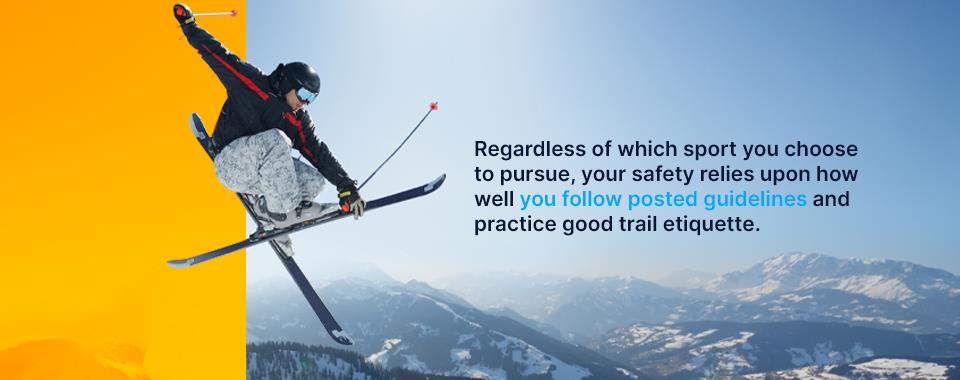
Ski Safety vs. Snowboard Safety
One thing most beginners worry about when considering skiing vs.
snowboarding difficulty is how safe the sport is. Regardless of which sport
you choose to pursue, your safety relies upon how well you follow posted
guidelines and practice good trail etiquette.
Abide by these tips to
ensure a safe outing
for you and fellow riders:
-
Maintain control of your board or skis at all times, remaining aware of
your surroundings and steering clear of people, obstacles and signs.
-
Stay on marked, approved trails only. Never go off-course or enter
restricted areas.
-
Never stop on a trail, obstructing other riders.
-
Yield to other riders, including when starting and merging.
-
Use all required equipment to minimize damage or injury during falls.
-
Learn how to use a ski lift before boarding and exiting one for the
first time. Avoid distractions or excessive movement while on the lift.
-
Protect your skin, eyes and lips from the sun and wind.
-
Only ride according to your skill level and experience. Do not graduate
until you're ready.
-
Dress according to the weather and temperature at the resort or trail
location.
-
Never go skiing or snowboarding alone, especially in unfamiliar
territory.
-
Ask for help when needed. Consider taking classes or beginner's courses
to learn more before and after your first ride.
-
Warm-up your muscles with stretches and light exercise before hitting
the trails.
-
Stay energized with nutritious meals. Hydrate often.
-
Know your physical limits and respect them. Take frequent breaks to
rest.
In terms of safety, you should also account for the types and styles of
tricks while skiing vs. snowboarding — some flips, turns and trails are
more challenging than others.
Learning Snowboarding vs. Skiing — Frequently Asked Questions
Learn more about these popular snowsports with these frequently asked
questions.
Which Is Harder — Skiing or Snowboarding?
Is skiing or snowboarding easier? Both the skiing and snowboarding learning
curves depend on how often you practice, your physical capabilities at the
time of learning and whether you participate in classes. Generally
speaking, beginners have an easier time with skiing because the
forward-facing position feels more natural, and some find snowboard
bindings restrictive.
However, skiing involves a lot of multitasking, and your hands aren't as
free to adjust your goggles or helmet as they are with a snowboard. Skiing
also requires constant balance, while snowboard bindings take some of the
work out of that. Snowboarding boots are also easier to walk in than ski
boots on most terrains.
What Is More Popular — Skiing or Snowboarding?
This depends on where you are and who you ask. Snowboarding tends to be
more niche — there are hundreds of ski resorts across the country, but not
all of them allow snowboarding or offer rentals. However, many snowboarders
and skiers spend time riding away from resorts, making them fairly equal in
popularity.
Is Skiing or Snowboarding More Fun?
This is entirely subjective. Many snowsports enthusiasts find they enjoy
engaging in both skiing and snowboarding, depending on their mood. If
you're teaching children, you may prefer skiing, as it's easier to guide
your new skiers along the trail by keeping them centered between your own
set.
What Is Faster — Skiing or Snowboarding?
Both sports can be fast — the world's fastest snowboarder on record reached
a speed of nearly
127 miles per hour
, while one of the fastest skiers hit about
157 miles per hour
. Of course, these were professional athletes performing in optimal
conditions after years of intense training. Even the most advanced
boarders' and skiers' averages are far slower.
Snowboard vs. ski speed is all about direction. Since skiing is usually
easier for beginners, you may find yourself reaching faster speeds sooner
than you would on a snowboard. Skiing also allows the rider to face forward
in a straight line, reducing the natural drag that interferes with speed.
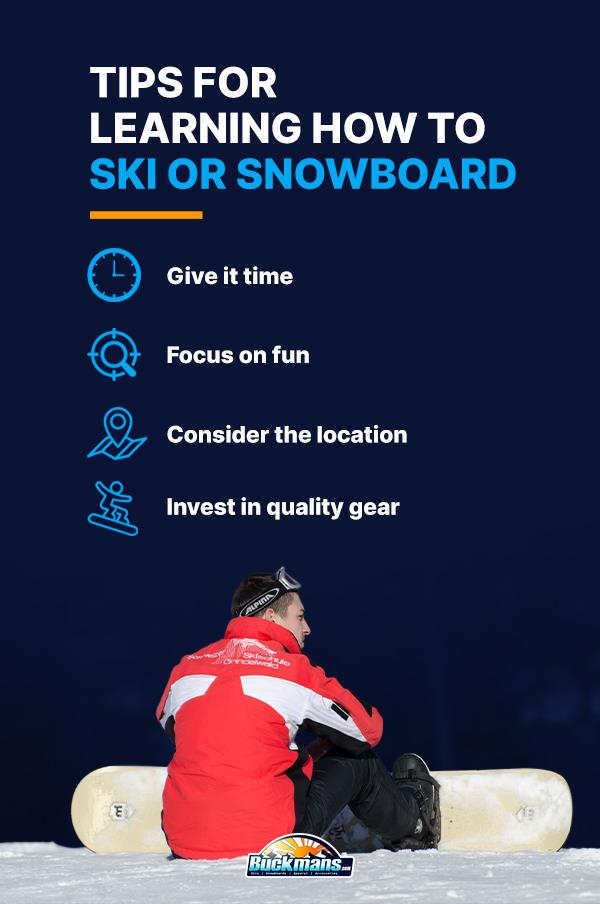
Tips for Learning How to Ski or Snowboard
Here are some tips for making the most of your new adventure:
-
Give it time: Practice may not make you a perfect rider, but it will
help you improve your skills and achieve more challenging tricks,
speeds and trails. Over time, you will become more attuned to the
natural movement of the snow and board or skis.
-
Focus on fun: The best part about either snow sport is how easy it is
to have a good time, regardless of your skill level. Bring along your
friends and family and make your new hobby a bonding experience.
-
Consider the location: Though mountaineering and exploration-based
riding is a popular winter pastime, more than
10 million snowboarders and skiers
visited designated resorts during the 2018 and 2019 snow season — the
highest turnout in the last several decades. This popularity is likely
due to the safe, controlled environment and convenient access to rental
equipment and facilities.
-
Invest in quality gear: If you find you enjoy your chosen sport and
have invested a lot of time in it, consider upgrading to better
equipment. Quality gear can help you meet goals faster and achieve more
on the trails, all while keeping you safer and more comfortable.
Is Skiing or Snowboarding Right for Me?
Should you ski or snowboard? The answer depends on the following factors:
-
Skills and abilities: Though skiing and snowboarding are for riders of
all types, specific abilities may lend themselves to one more than the
other. For example, if you excel at multitasking, you might have an
easier time adapting to managing two skis and two poles, while those
who prefer a singular focus may enjoy snowboarding more.
-
Prior experience: Past experiences and other hobbies may determine
which sport you pick up the quickest. For instance, surfers and
skateboarders often have an easier time adapting to snowboarding,
thanks to the similar postures and movements required.
-
Fitness and strength: Consider your fitness level. Both sports will
help you build muscle and strength all over your body, but skiing tends
to put more emphasis on your legs, while snowboarding requires a lot of
core engagement. You may want to consult a physician before attempting
a new sport or exercise regime, especially if you have pre-existing
medical conditions.
-
Friends and family: If you have friends or family who prefer one sport,
you may already be familiar with the terminology and required skills.
It's also a great opportunity to spend time together.
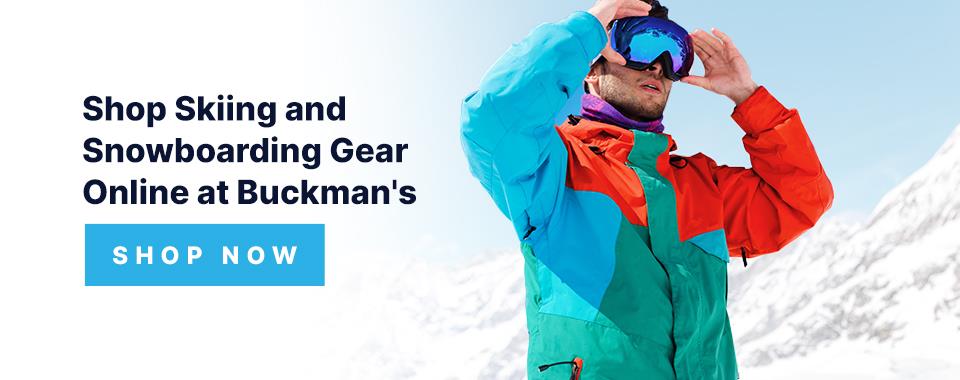
Shop Skiing and Snowboarding Gear Online at Buckman's
When it comes to skiing vs. snowboarding for beginners, you should choose
the sport that feels the most exciting and interesting to you. If you're
still not sure, give both a try — you may find you enjoy them equally.
Buckman’s Ski and Snowboard Shop is a family-owned and operated business
that specializes in helping beginners and experienced riders alike find the
gear and equipment they need to be successful. We're passionate about
snowsports, and each member of our team has the experience and industry
knowledge to help you find exactly what you need for your physique and
preferred sport. Browse our online inventory of ski equipment and
snowboarding gear
today to get started.
Tagged: ski, snowboard, ski and snowboard equipment